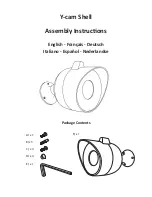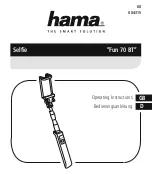
Basic TEACH Instructions
Use the following instructions to teach the Q4X sensor. The instructions provided on the sensor display vary depending on the type
of TEACH mode selected. Two-point TEACH is the default TEACH mode.
1. Press and hold
TEACH
for longer than 2 seconds to start the selected TEACH mode.
2. Present the target.
3. Press
TEACH
to teach the target. The target is taught and the sensor waits for the second target, if required by the selected
TEACH mode, or returns to Run mode.
Complete steps 4 and 5 only if required for the selected TEACH mode:
4. Present the second target.
5. Press
TEACH
to teach the target. The target is taught and the sensor returns to Run mode.
See the Instruction Manual for detailed instructions and other available TEACH modes. The TEACH modes include:
•
Two-point static background suppression
—Two-point TEACH sets a single switch point. The sensor sets the switch
point between two taught target distances, relative to the shifted origin location.
•
Dynamic background suppression
—Dynamic TEACH sets a single switch point during machine run conditions. The
sensor takes multiple samples and the switch point is set between the minimum and the maximum sampled distances.
•
One-point window (foreground suppression)
—One-point window sets a window (two switch points) centered around
the taught target distance.
•
One-point background suppression
—One-point background suppression sets a single switch point in front of the
taught target distance. Objects beyond the taught switch point are ignored.
•
Dual int distance
—Dual mode records the distance and amount of light received from the reference surface.
See for more information about selecting a reference surface. The output switches when an object passing between the
sensor and the reference surface changes the perceived distance or amount of returned light.
Manual Adjustments
Manually adjust the sensor switch point using the
and
buttons.
1. From Run mode, press either
or
one time. The current switch point value flashes slowly.
2. Press
to move the switch point up or
to move the switch point down. After 1 second of inactivity, the new switch
point value flashes rapidly, the new setting is accepted, and the sensor returns to Run mode.
Note:
When FGS mode is selected (FGS indicator is on), manual adjustment moves both sides of the
symmetrical threshold window simultaneously, expanding and collapsing the window size. Manual adjustment
does not move the center point of the window.
Note:
When dual mode is selected (DYN, FGS, and BGS indicators are on), after the TEACH process is
completed, use the manual adjustment to adjust the sensitivity of the thresholds around the taught reference
point. The taught reference point is a combination of the measured distance and returned signal intensity from
the reference target. Manual adjustment does not move the taught reference point, but pressing
increases
the sensitivity, and pressing
decreases the sensitivity. When re-positioning the sensor or changing the
reference target, re-teach the sensor.
Light Operate/Dark Operate
The default output configuration is light operate. To switch between light operate and dark operate, use the following instructions:
1. Press and hold
LO/DO
for longer than 2 seconds. The current selection displays.
2. Press
LO/DO
again. The new selection flashes slowly.
3. Press
SELECT
to change the output configuration and return to Run mode.
Note:
If neither
SELECT
nor
LO/DO
are pressed after step 2, the new selection flashes slowly for a few
seconds, then flashes quickly and the sensor automatically changes the output configuration and returns
to Run mode.
Locking and Unlocking the Sensor Buttons
Use the lock and unlock feature to prevent unauthorized or accidental programming changes.
Three settings are available:
•
—The sensor is unlocked and all settings can be modified (default).
•
— The sensor is locked and no changes can be made.
Q4X Stainless Steel Laser Sensor
6
www.bannerengineering.com - Tel: + 1 888 373 6767
P/N 181484 Rev. N






























